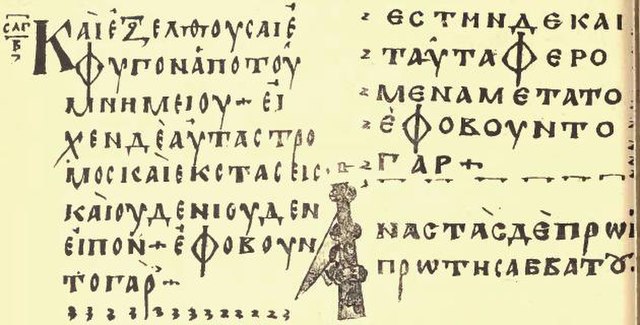The Gospel of Matthew is the first book of the New Testament of the Bible and one of the three synoptic Gospels. It tells how Israel's Messiah, Jesus, comes to his people but is rejected by them and how, after his resurrection, he sends the disciples to the gentiles instead. Matthew wishes to emphasize that the Jewish tradition should not be lost in a church that was increasingly becoming gentile. The gospel reflects the struggles and conflicts between the evangelist's community and the other Jews, particularly with its sharp criticism of the scribes and Pharisees with the position that through their rejection of Christ, the Kingdom of God has been taken away from them and given instead to the church.
Matthew 21:34–37 on Papyrus 104 (c. AD 150)
Papyrus 𝔓4, fragment of a flyleaf with the title of the Gospel of Matthew, ευαγγελιον κ̣ατ̣α μαθ᾽θαιον, euangelion kata Maththaion. Dated to late 2nd or early 3rd century, it is the earliest manuscript title for Matthew.
The New Testament (NT) is the second division of the Christian biblical canon. It discusses the teachings and person of Jesus, as well as events relating to first-century Christianity. The New Testament's background, the first division of the Christian Bible, is called the Old Testament, which is based primarily upon the Hebrew Bible; together they are regarded as Sacred Scripture by Christians.
Evangelist Mathäus und der Engel, by Rembrandt, 1661
Saint Paul Writing His Epistles by Valentin de Boulogne (c. 1618–1620). Most scholars think Paul actually dictated his letters to a secretary.
Papyrus Bodmer VIII, at the Biblioteca Apostolica Vaticana, showing 1 and 2 Peter.
The Codex Regius (L or 019), an 8th-century Greek manuscript of the New Testament with strong affinities to Codex Vaticanus.






